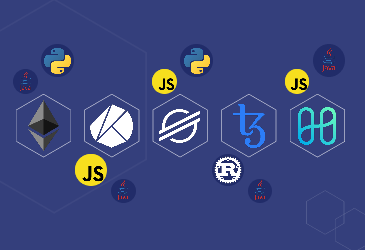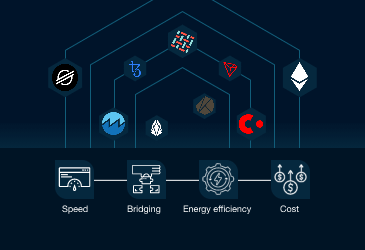
Tezos blockchain – The first self-amending blockchain
Legacy blockchains have several limitations concerning security, scalability, and more. These weaknesses associated with blockchains often cause issues and dissatisfaction in users. Sometimes, it results in the forking or splitting of the blockchain, leading to disparity in the community.
Tezos was launched to solve such problems existing in legacy blockchain platforms. The founders of Tezos envisioned it would evolve the blockchain space and promote a DeFi revolution.
Tezos aims to solve the problems of DeFi, such as transaction costs and smart contract issues, through its unique infrastructure and mechanisms.
What is Tezos?
Tezos is an open-source blockchain protocol “designed to evolve“ and develop smoothly. It is essentially a smart contract and decentralized application development platform. The ecosystem has its own utility token, Tez (XTZ), in addition to a native smart contract language called Michelson. The platform is secured and managed by Tezos bakers, similar to miners, and they verify transactions, distribute block rewards and ensure the network is secure.
Benefits of Tezos blockchain:
-
It has a modular architecture
-
It is powerfully scalable
-
Block time is one minute per block
-
Enables 40 transactions per second
-
Offers regular upgradeability without forking
-
Future-proof
-
Low power consumption
History of Tezos
Tezos was conceptualized by the husband and wife duo Arthur Breitman and Kathleen Breitman, who began the Tezos project in 2014. Arthur Breitman was a former engineer at Google X and Waymo and later became a quantitative analyst at Morgan Stanley (MS). His partner, Kathleen Breitman, worked at the hedge fund firm Bridgewater Associates and R3, a software company.
The whitepaper for Tezos, which outlined the principles behind this network, was published in 2014 by Arthur by the pseudonym L.M Goodman. In his whitepaper, Arthur pointed out the flaws of legacy blockchains, especially Bitcoin and put forward his solution of a self-amending cryptocurrency.
In 2017, Arthur Breitman teamed up with Johann Gevers, a Swiss entrepreneur and created the Tezos Foundation in Zug to back the project. .
Tezos architecture
The Tezos blockchain has three major protocols that act as the backbone of the ecosystem, which are:
Network protocol
The network protocol is utilized to finalize blocks and broadcast them across the network. Simply put, it connects the “gossip” network with the protocol. Whatever the nodes of the network are required to keep the integrity of the network, like connecting users, downloading the blockchain state and broadcasting the verified blocks to the network, is all carried out in the network protocol.
Transaction protocol
The transaction protocol determines the validity of transactions, keeps a record of every blockchain information and ensures valid transactions in the network.
Consensus protocol
The consensus protocol is responsible for maintaining a seamless consensus process happening in the network. Any blockchain modification, upgradation or addition must be voted upon by stakeholders and has to go through the consensus protocol.
The network shell, also known as the “blockchain protocol,” connects these different protocols in the Tezos ecosystem.
The consensus mechanism
Tezos validates transactions through the Proof-of-Stake, more precisely, Liquid Proof-of-Stake consensus mechanism in which participants need to stake their cryptocurrencies to add new blocks to the blockchain. The method of validating and adding new blocks to the network is known as baking in Tezos. Unlike other PoS protocols where only people with most cryptocurrencies can participate, Tezos allows any stakeholder having the required XTZ tokens (minimum 6000 XTZ) to participate in the consensus process. The participating validators, also known as bakers, get incentivized by the protocol for their contribution to the stability and security of the network. Moreover, PoS is comparatively less expensive and also lowers the barriers to entry for inclusion.
Delegation
The Tezos blockchain gives users the right to delegate their consensus participation to other users if they are unwilling to engage in the consensus mechanism. If a user does not possess 6000 XTZ or does not wish to set up the node infrastructure to bake blocks, they are allowed to delegate or lend their coins to another baker. In turn, the person who lends or delegates the tokens can get an additional revenue generated from the delegated tokens in proportion to the baker’s participation.
How secure is Tezos’s consensus mechanism?
Generally, in Proof-of-Stake consensus, participants must deposit a certain amount of their tokens as security to avoid malicious behavior. The Tezos protocol, too, demands a security deposit from its participants. However, similar to Proof-of-Work, it depends on the honest majority to upkeep its security which gets incentivized. Similarly, if the network finds any fraudulent activities, the bad actors get penalized and can lose their security deposit. The users are also given the option to delegate their rights.
What languages does Tezos blockchain use?
OCaml
OCaml is a robust general-purpose programming language. It is an easy language to debug and maintain and is also strong in expressiveness and safety. It was created in 1996 and consists of a large standard library, proving useful for several similar applications like Python or Perl. Its modular and object-oriented programming constructs make it suitable for large-scale software engineering.
Some top projects utilizing OCaml are Docker, Facebook, Wikipedia, Bloomberg and more. OCaml is the language of Tezos protocol.
Michelson
Michelson is a relatively new language introduced by Arthur Breitman in the Tezos whitepaper. It is an open-source and functional programming language introduced for smart contract development in Tezos. It was designed to enable formal verification to prove the properties of the user’s contracts. One of the major benefits of the language is that it is introspectable and offers readable bytecode.
Tezos also provides high-level programming languages for smart contract development, like SmartPy, LIGO, and Morley/Lorentz.
SmartPy – It is a high-level language that facilitates developers to write smart contracts in Python and then compile them to Michelson.
LIGO – It is a smart contract language for Tezos, offering a robust, static type system and smooth integration.
Key features
-
Self-amendment
It permits Tezos to evolve and upgrade itself without forking, thus reducing hard fork and fraction in the community. This feature helps the protocol improve itself over time and seamlessly implement future innovations.
-
On-chain governance
All stakeholders in the Tezos blockchain network can engage in governing the protocol. The election cycle provides stakeholders with a formal and systematic approach to establishing agreement on proposed protocol revisions.
-
Decentralized innovation
Payment to people or groups who improve the protocol might be included in proposed revisions that stakeholders agree to. This funding method fosters strong participation and decentralizes the network upkeep.
-
Institutional grade security
The architecture of Tezos offers the safety and code correctness needed for assets and other significant use cases at the protocol and application layer. Michelson and OCaml programming languages of Tezos facilitate formal verification and makes this possible.
-
Smart contracts and formal verification
The smart contracts of Tezos utilize formal verification, enabling them to be mathematically verified, secure and reliable. It improves the security of the network and can assist in avoiding bugs.
What issues does Tezos blockchain solve?
Many first-generation blockchain networks like Bitcoin and Ethereum have several limitations that can be fixed only via important upgrades. In some cases, scaling, security and other issues can only be fixed by forking the blockchain, resulting in a disrupted and divided network community. This is where the Tezos blockchain outstrips legacy blockchains as it gets upgraded through its self-amending network.
The self-amending strategy of Tezos blockchain enables users to vote on any important network change, which executes itself without requiring any hard forks. This solution Tezos implements to prevent hard forks is known as the “self-amending crypto ledger.”
Tezos blockchain’s evolution and upgradations so far
As “a blockchain designed to evolve,” Tezos has considered the ongoing advancements in the blockchain space and the growing demand of web3 users to evolve into the desired ecosystem that users need. Adhering to the self-amendment and on-chain governance model of Tezos, the first proposal to upgrade the blockchain was made in May 2019. This proposal was named “Athens” and suggested reducing the baking threshold from 10,000 XTZ to 8,000 XTZ. Athens also recommended increasing Tezos’s gas limit per block to enable more intricate transactions to be processed. This proposal was also then integrated into the blockchain.
Tezos has undergone several upgrades ever since. Let us walk through each upgrade that happened in the Tezos blockchain.
-
Babylon, October 2019 – This upgrade proposal aimed to improve and reinforce vital processes in Tezos’ functionality. It suggested simplifying the staking, transferring and sharing processes to make them more seamless for users.
-
Carthage, March 2020 – This proposal emphasized having a more organized and polished ecosystem and focused on code cleanup, optimization and resolving minor issues in the chain.
-
Delphi, September 2020 – Delphi proposed practical solutions to the gas and storage costs. This suggestion aided in significantly decreasing the issues of Tezos, as mentioned earlier.
-
Edo, February 2021 – Edo mainly focused on upgrading Tezos’s governance and amendment processes. It also added an “adoption” period into the governance model of Tezos that permits each stakeholder in the network to prepare for any changes that future proposals might include.
-
Florence, May 2021 – Florence doubled the maximum operation size of the network, put forward more instinctive smart contract writing processes, and refined the gas economies of Tezos.
-
Granada, August 2021 – It suggested a solution, liquidity baking, to the liquidity issues that existed in the Tezos network. Liquidity baking incentivized the liquidity providers of the ecosystem. Granada also decreased the gas consumption cost and launched the “Emmy” consensus algorithm.
-
Hangzhou, December 2021 – It introduced several features like time-lock encryption, caching, views etc., to smoothen the developer experience while building new blockchain-based projects.
-
Ithaca, February 2022 – Although Ithaca upgradation was proposed, it was later rejected as the majority of the votes did not support this proposal.
-
Ithaca2, April 2022 – A new version of Ithaca was suggested in April 2022 that proposed a significant update to the consensus algorithm of Tezos named “Tenderbake.” It also lowered the minimum number of XTZ required to become a validator from 8,000 XTZ to 6,000 XTZ and proposed faster finality and seamless running of applications on Tezos.
-
Jakarta – Jakarta is the tenth and the latest update suggestion to the Tezos blockchain. It suggested including a Layer 2 blockchain upscaling solution named Transactional Optimistic Rollups (TORUs) into the ecosystem.
Conclusion
Tezos is a promising platform offering robust technical innovations through its on-chain governance and self-amendment model. As a blockchain network designed to evolve, it has undergone major upgrades to become a technologically advanced and highly flexible network. It can adapt seamlessly to the growing demand of web3 users. And its capability to upgrade without a hard fork adds to its charm. It is an ideal ecosystem for developers to build dApps, smart contracts and other decentralized solutions and services for high-value use cases.
If you want to know the performance of the Tezos network, its ecosystem score and ranking, the foundation tools it provides, and more, you can check out the Tezos review and rating on Scortik.
Insights

What are SDKs? Top blockchains and their SDKs
A software development kit or SDK is a set of tools and programs utilized to build and integrate customized applications for any existing or new platform.

How to Choose a Blockchain Protocol Suitable to Your Project?
Need help choosing the right blockchain protocol for your project? Use Scortik to evaluate protocols’ overall performance and make the right choice.

WanChain: Empowering Blockchains With Interoperability
Wanchain is a blockchain interoperability and decentralized finance platform that connects multiple blockchains with one another.